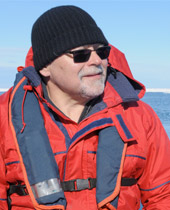My main background is in ecology and environmental science, with a focus on aquatic ecosystems. I further specialize on examining long-term histories of lakes from the information contained in lake and pond sediments. From these data, we can reconstruct how climate has changed and how other anthropogenic impacts are affecting our planet.
We often refer to the Arctic as “the miner’s canaries of the planet”. Just as the coal miners used to bring caged canaries into their coal mines as early warning indicators of increasing sulfur gas, the Arctic is often the first to show signs of environmental change and to the greatest degree. What happens in the Arctic can affect us all. This is especially true of climate change. The North and Northerners are on the frontline of climate change. Although not trying to detract from the spectacular beauty of the places we will visit, part of my presentations will inevitably focus on our research showing how vulnerable we are to anthropogenic impacts of accelerated warming. The Arctic is also at risk to a spectrum of other issues, such as long-range transport of pollutants, affecting the local ecosystems and the people who are dependent on them.

My research has also led me to work closely with Arctic archeologists, tracking how northern peoples have adapted and survived in this environment. Hopefully we will have the opportunity to visit some of these interesting sites, such as the abandoned over-wintering camps of the Thule whalers, who mastered the use of boats and harpoons to hunt bowhead whales, some 800 years ago.
And, of course, one of the highlights of any Arctic trip is visiting some of the northern communities. Here, one can learn about the challenges of living in this environment, as well as learning about the local culture, art, and traditions.
Most Canadians would be surprised to know that approximately half of our land mass and about two thirds of our coastline are in the Arctic. We are an Arctic nation, and one that is the steward of a large area of the planet that is changing and changing fast. The better we understand this environment, the better we can make evidence-based policy decisions on its future and that of our planet. One point I am certain of – no one will ever forget this trip.



